SHR018-3 - HRM: Analyzing Contemporary Issues at ITUSA Case Study
VerifiedAdded on 2023/06/17
|7
|2523
|287
Essay
AI Summary
This essay provides an analysis of the key Human Resource Management (HRM) issues impacting the workplace environment within the context of the ITUSA case study. It explores the concepts of diversity and inclusion, highlighting their importance in fostering a positive and productive work environment. The essay delves into various relevant theories such as Cognitive Diversity Theory, Similarity-Attraction Paradigm, Social Cognitive Theory, Social Identity Theory, and Schema Theory, examining their implications for managing diversity and inclusion effectively. Furthermore, it critically analyzes the HRM functions within ITUSA, addressing challenges related to cultural diversity and organizational fit, and offers practical recommendations to enhance employee engagement, reduce turnover, and improve overall organizational performance. The analysis emphasizes the need for organizations to proactively manage diversity and inclusion to create a more inclusive and equitable workplace.
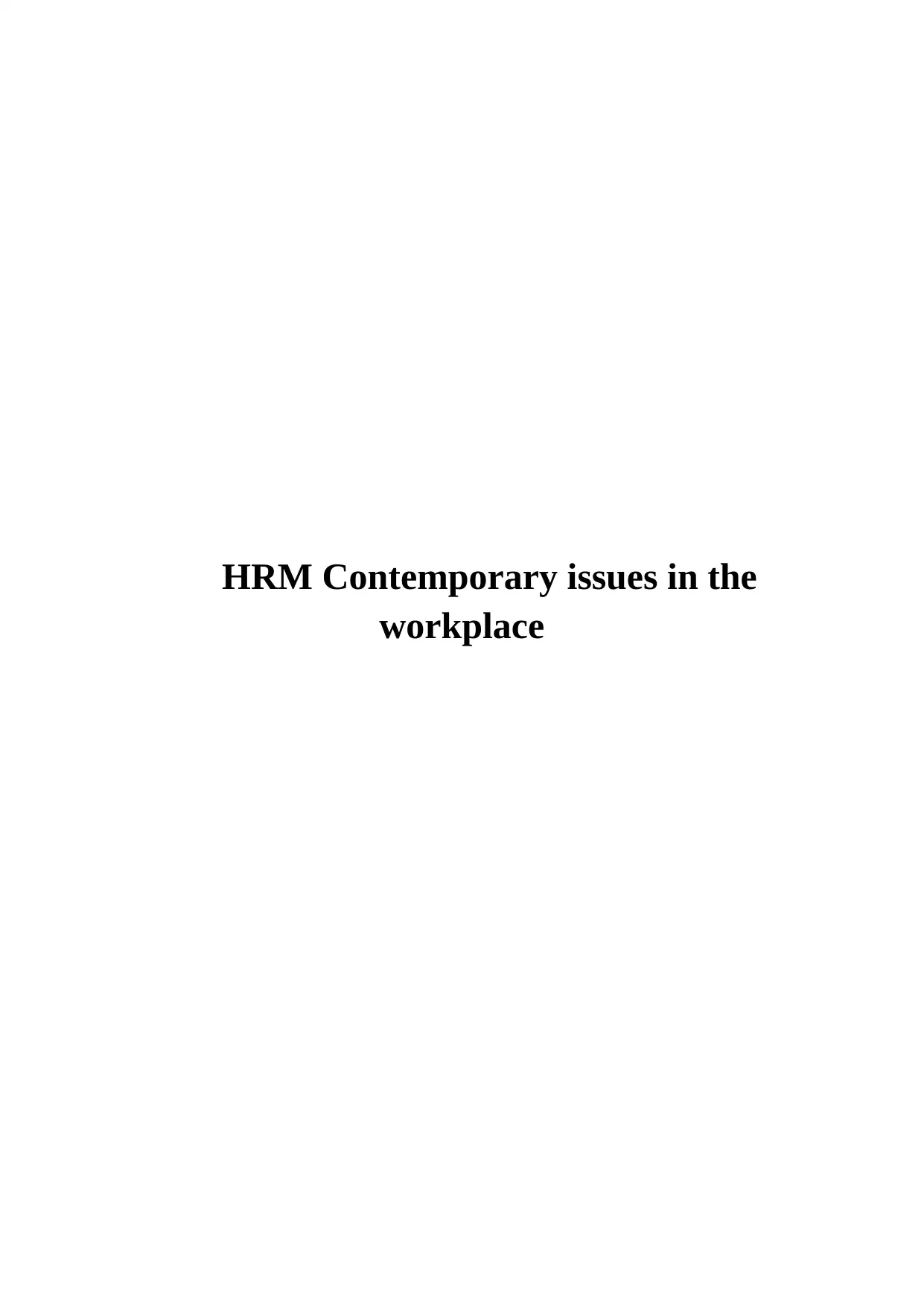
HRM Contemporary issues in the
workplace
workplace
Paraphrase This Document
Need a fresh take? Get an instant paraphrase of this document with our AI Paraphraser
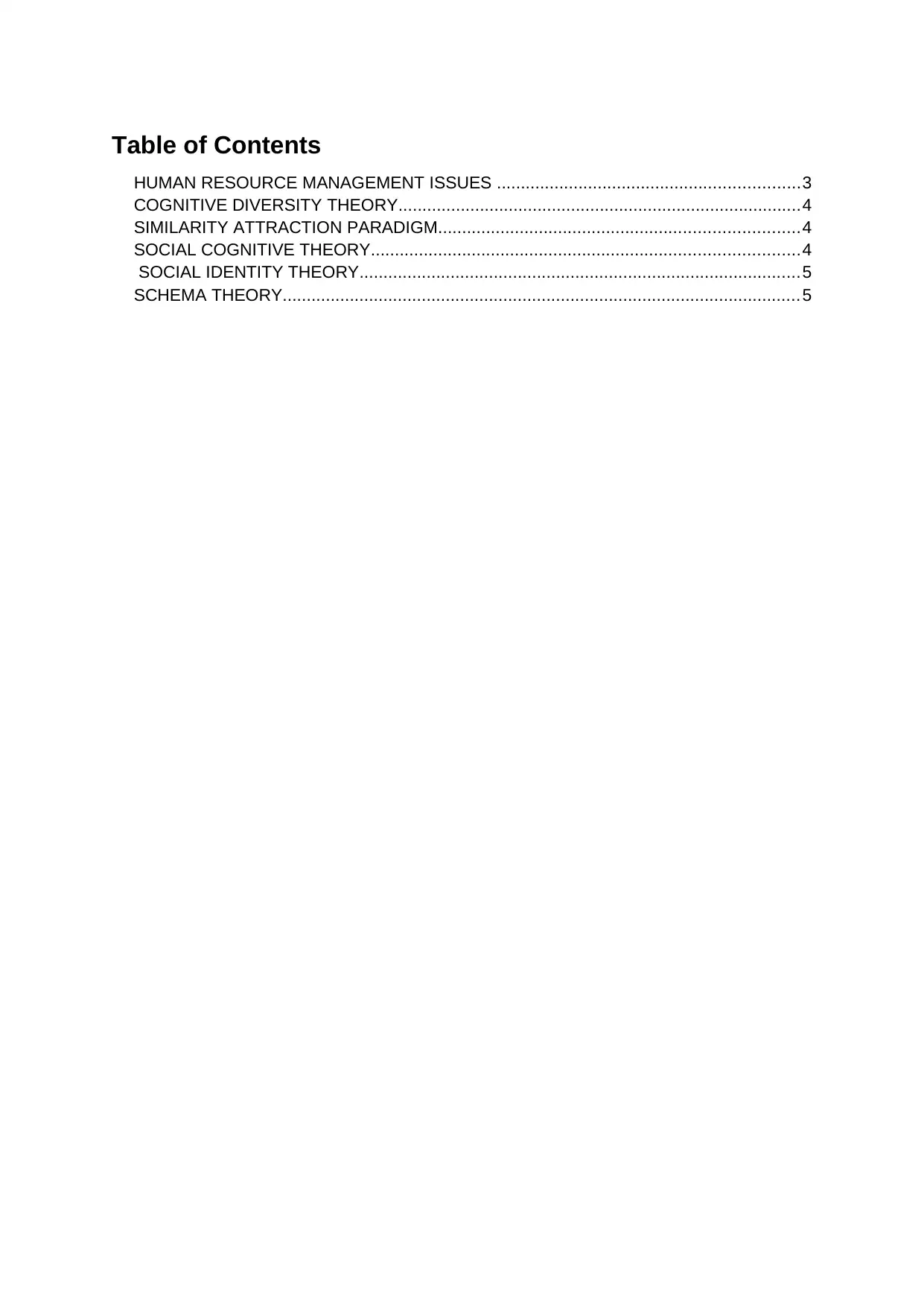
Table of Contents
HUMAN RESOURCE MANAGEMENT ISSUES ...............................................................3
COGNITIVE DIVERSITY THEORY....................................................................................4
SIMILARITY ATTRACTION PARADIGM...........................................................................4
SOCIAL COGNITIVE THEORY.........................................................................................4
SOCIAL IDENTITY THEORY............................................................................................5
SCHEMA THEORY............................................................................................................5
HUMAN RESOURCE MANAGEMENT ISSUES ...............................................................3
COGNITIVE DIVERSITY THEORY....................................................................................4
SIMILARITY ATTRACTION PARADIGM...........................................................................4
SOCIAL COGNITIVE THEORY.........................................................................................4
SOCIAL IDENTITY THEORY............................................................................................5
SCHEMA THEORY............................................................................................................5
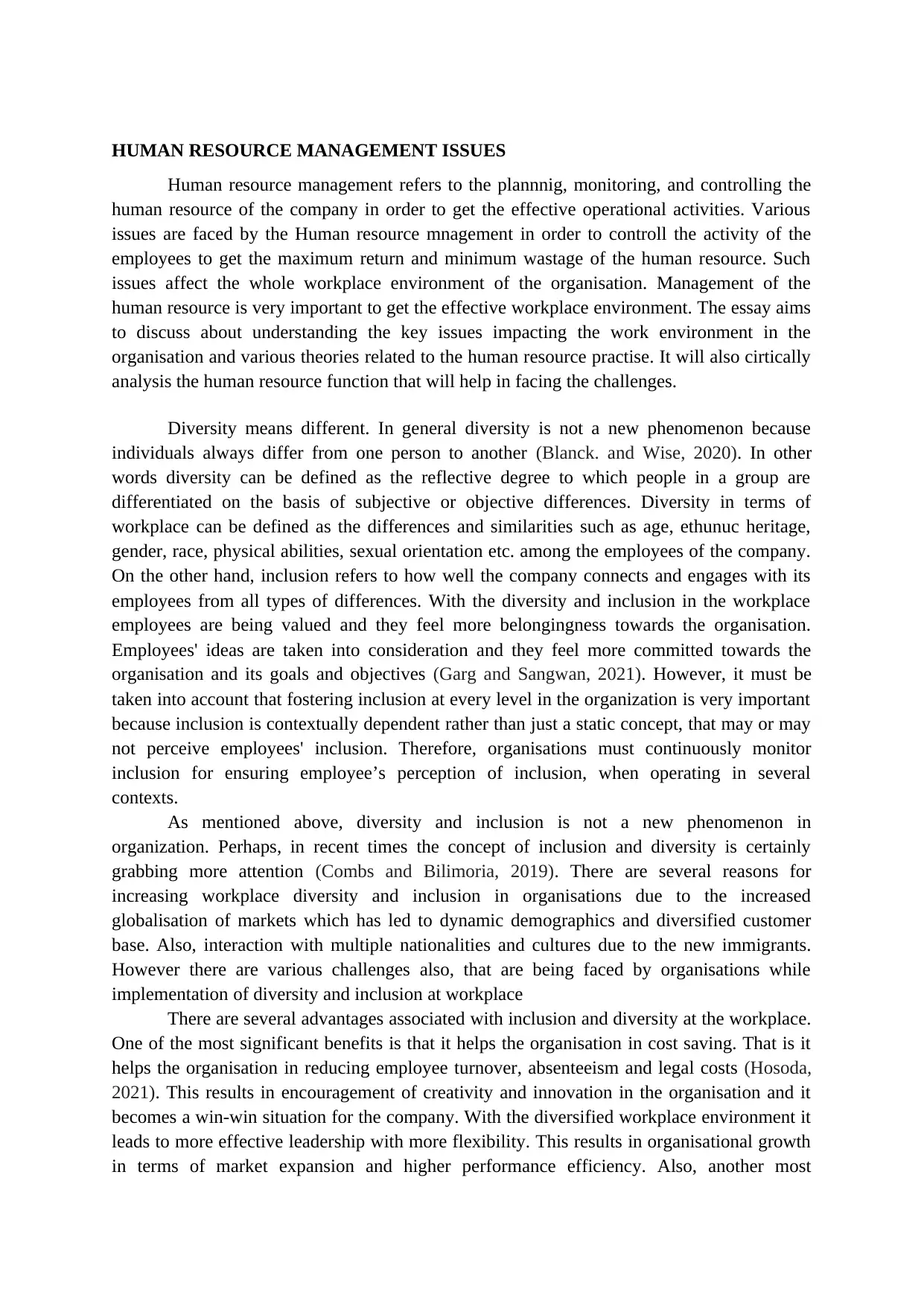
HUMAN RESOURCE MANAGEMENT ISSUES
Human resource management refers to the plannnig, monitoring, and controlling the
human resource of the company in order to get the effective operational activities. Various
issues are faced by the Human resource mnagement in order to controll the activity of the
employees to get the maximum return and minimum wastage of the human resource. Such
issues affect the whole workplace environment of the organisation. Management of the
human resource is very important to get the effective workplace environment. The essay aims
to discuss about understanding the key issues impacting the work environment in the
organisation and various theories related to the human resource practise. It will also cirtically
analysis the human resource function that will help in facing the challenges.
Diversity means different. In general diversity is not a new phenomenon because
individuals always differ from one person to another (Blanck. and Wise, 2020). In other
words diversity can be defined as the reflective degree to which people in a group are
differentiated on the basis of subjective or objective differences. Diversity in terms of
workplace can be defined as the differences and similarities such as age, ethunuc heritage,
gender, race, physical abilities, sexual orientation etc. among the employees of the company.
On the other hand, inclusion refers to how well the company connects and engages with its
employees from all types of differences. With the diversity and inclusion in the workplace
employees are being valued and they feel more belongingness towards the organisation.
Employees' ideas are taken into consideration and they feel more committed towards the
organisation and its goals and objectives (Garg and Sangwan, 2021). However, it must be
taken into account that fostering inclusion at every level in the organization is very important
because inclusion is contextually dependent rather than just a static concept, that may or may
not perceive employees' inclusion. Therefore, organisations must continuously monitor
inclusion for ensuring employee’s perception of inclusion, when operating in several
contexts.
As mentioned above, diversity and inclusion is not a new phenomenon in
organization. Perhaps, in recent times the concept of inclusion and diversity is certainly
grabbing more attention (Combs and Bilimoria, 2019). There are several reasons for
increasing workplace diversity and inclusion in organisations due to the increased
globalisation of markets which has led to dynamic demographics and diversified customer
base. Also, interaction with multiple nationalities and cultures due to the new immigrants.
However there are various challenges also, that are being faced by organisations while
implementation of diversity and inclusion at workplace
There are several advantages associated with inclusion and diversity at the workplace.
One of the most significant benefits is that it helps the organisation in cost saving. That is it
helps the organisation in reducing employee turnover, absenteeism and legal costs (Hosoda,
2021). This results in encouragement of creativity and innovation in the organisation and it
becomes a win-win situation for the company. With the diversified workplace environment it
leads to more effective leadership with more flexibility. This results in organisational growth
in terms of market expansion and higher performance efficiency. Also, another most
Human resource management refers to the plannnig, monitoring, and controlling the
human resource of the company in order to get the effective operational activities. Various
issues are faced by the Human resource mnagement in order to controll the activity of the
employees to get the maximum return and minimum wastage of the human resource. Such
issues affect the whole workplace environment of the organisation. Management of the
human resource is very important to get the effective workplace environment. The essay aims
to discuss about understanding the key issues impacting the work environment in the
organisation and various theories related to the human resource practise. It will also cirtically
analysis the human resource function that will help in facing the challenges.
Diversity means different. In general diversity is not a new phenomenon because
individuals always differ from one person to another (Blanck. and Wise, 2020). In other
words diversity can be defined as the reflective degree to which people in a group are
differentiated on the basis of subjective or objective differences. Diversity in terms of
workplace can be defined as the differences and similarities such as age, ethunuc heritage,
gender, race, physical abilities, sexual orientation etc. among the employees of the company.
On the other hand, inclusion refers to how well the company connects and engages with its
employees from all types of differences. With the diversity and inclusion in the workplace
employees are being valued and they feel more belongingness towards the organisation.
Employees' ideas are taken into consideration and they feel more committed towards the
organisation and its goals and objectives (Garg and Sangwan, 2021). However, it must be
taken into account that fostering inclusion at every level in the organization is very important
because inclusion is contextually dependent rather than just a static concept, that may or may
not perceive employees' inclusion. Therefore, organisations must continuously monitor
inclusion for ensuring employee’s perception of inclusion, when operating in several
contexts.
As mentioned above, diversity and inclusion is not a new phenomenon in
organization. Perhaps, in recent times the concept of inclusion and diversity is certainly
grabbing more attention (Combs and Bilimoria, 2019). There are several reasons for
increasing workplace diversity and inclusion in organisations due to the increased
globalisation of markets which has led to dynamic demographics and diversified customer
base. Also, interaction with multiple nationalities and cultures due to the new immigrants.
However there are various challenges also, that are being faced by organisations while
implementation of diversity and inclusion at workplace
There are several advantages associated with inclusion and diversity at the workplace.
One of the most significant benefits is that it helps the organisation in cost saving. That is it
helps the organisation in reducing employee turnover, absenteeism and legal costs (Hosoda,
2021). This results in encouragement of creativity and innovation in the organisation and it
becomes a win-win situation for the company. With the diversified workplace environment it
leads to more effective leadership with more flexibility. This results in organisational growth
in terms of market expansion and higher performance efficiency. Also, another most
⊘ This is a preview!⊘
Do you want full access?
Subscribe today to unlock all pages.

Trusted by 1+ million students worldwide
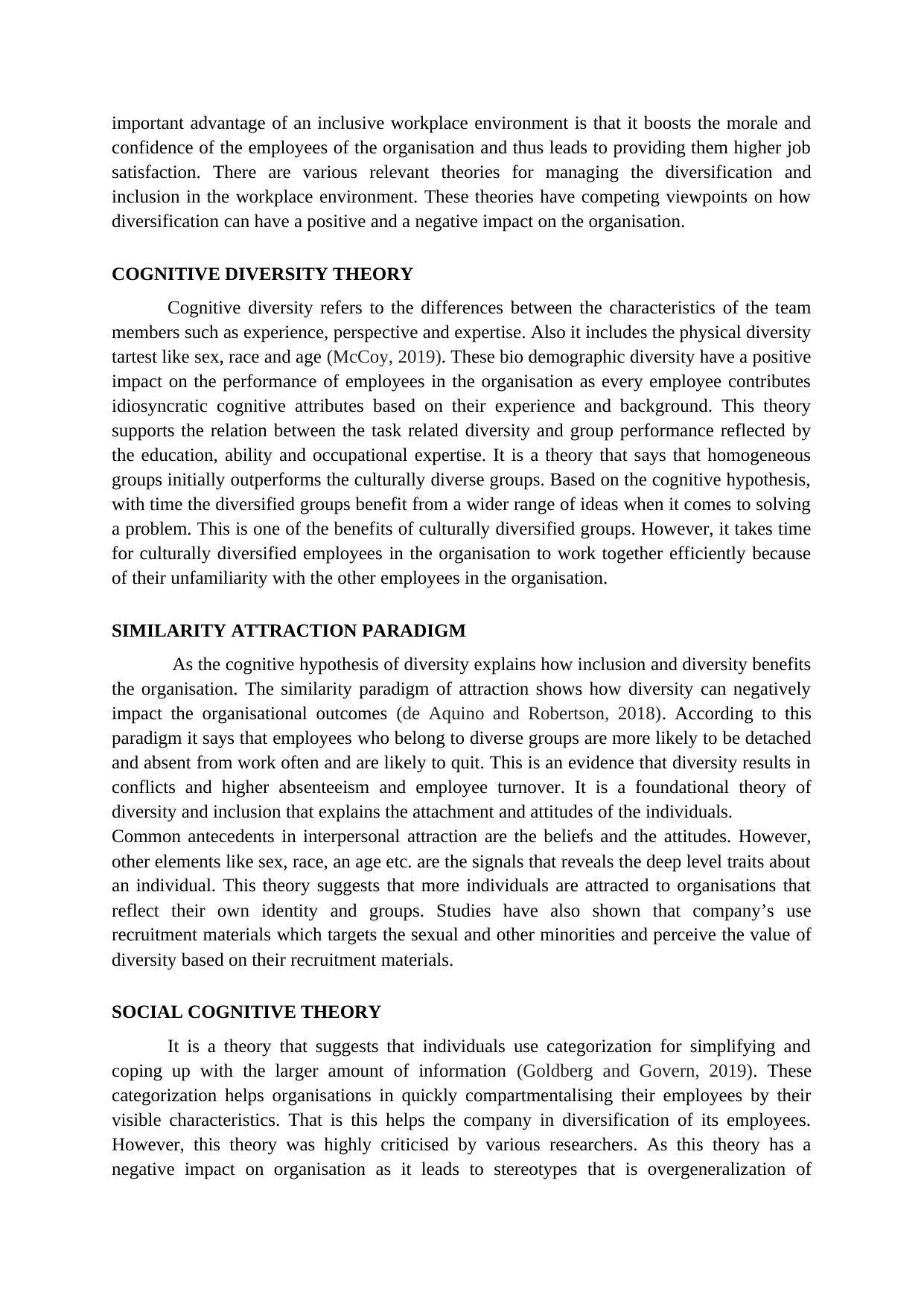
important advantage of an inclusive workplace environment is that it boosts the morale and
confidence of the employees of the organisation and thus leads to providing them higher job
satisfaction. There are various relevant theories for managing the diversification and
inclusion in the workplace environment. These theories have competing viewpoints on how
diversification can have a positive and a negative impact on the organisation.
COGNITIVE DIVERSITY THEORY
Cognitive diversity refers to the differences between the characteristics of the team
members such as experience, perspective and expertise. Also it includes the physical diversity
tartest like sex, race and age (McCoy, 2019). These bio demographic diversity have a positive
impact on the performance of employees in the organisation as every employee contributes
idiosyncratic cognitive attributes based on their experience and background. This theory
supports the relation between the task related diversity and group performance reflected by
the education, ability and occupational expertise. It is a theory that says that homogeneous
groups initially outperforms the culturally diverse groups. Based on the cognitive hypothesis,
with time the diversified groups benefit from a wider range of ideas when it comes to solving
a problem. This is one of the benefits of culturally diversified groups. However, it takes time
for culturally diversified employees in the organisation to work together efficiently because
of their unfamiliarity with the other employees in the organisation.
SIMILARITY ATTRACTION PARADIGM
As the cognitive hypothesis of diversity explains how inclusion and diversity benefits
the organisation. The similarity paradigm of attraction shows how diversity can negatively
impact the organisational outcomes (de Aquino and Robertson, 2018). According to this
paradigm it says that employees who belong to diverse groups are more likely to be detached
and absent from work often and are likely to quit. This is an evidence that diversity results in
conflicts and higher absenteeism and employee turnover. It is a foundational theory of
diversity and inclusion that explains the attachment and attitudes of the individuals.
Common antecedents in interpersonal attraction are the beliefs and the attitudes. However,
other elements like sex, race, an age etc. are the signals that reveals the deep level traits about
an individual. This theory suggests that more individuals are attracted to organisations that
reflect their own identity and groups. Studies have also shown that company’s use
recruitment materials which targets the sexual and other minorities and perceive the value of
diversity based on their recruitment materials.
SOCIAL COGNITIVE THEORY
It is a theory that suggests that individuals use categorization for simplifying and
coping up with the larger amount of information (Goldberg and Govern, 2019). These
categorization helps organisations in quickly compartmentalising their employees by their
visible characteristics. That is this helps the company in diversification of its employees.
However, this theory was highly criticised by various researchers. As this theory has a
negative impact on organisation as it leads to stereotypes that is overgeneralization of
confidence of the employees of the organisation and thus leads to providing them higher job
satisfaction. There are various relevant theories for managing the diversification and
inclusion in the workplace environment. These theories have competing viewpoints on how
diversification can have a positive and a negative impact on the organisation.
COGNITIVE DIVERSITY THEORY
Cognitive diversity refers to the differences between the characteristics of the team
members such as experience, perspective and expertise. Also it includes the physical diversity
tartest like sex, race and age (McCoy, 2019). These bio demographic diversity have a positive
impact on the performance of employees in the organisation as every employee contributes
idiosyncratic cognitive attributes based on their experience and background. This theory
supports the relation between the task related diversity and group performance reflected by
the education, ability and occupational expertise. It is a theory that says that homogeneous
groups initially outperforms the culturally diverse groups. Based on the cognitive hypothesis,
with time the diversified groups benefit from a wider range of ideas when it comes to solving
a problem. This is one of the benefits of culturally diversified groups. However, it takes time
for culturally diversified employees in the organisation to work together efficiently because
of their unfamiliarity with the other employees in the organisation.
SIMILARITY ATTRACTION PARADIGM
As the cognitive hypothesis of diversity explains how inclusion and diversity benefits
the organisation. The similarity paradigm of attraction shows how diversity can negatively
impact the organisational outcomes (de Aquino and Robertson, 2018). According to this
paradigm it says that employees who belong to diverse groups are more likely to be detached
and absent from work often and are likely to quit. This is an evidence that diversity results in
conflicts and higher absenteeism and employee turnover. It is a foundational theory of
diversity and inclusion that explains the attachment and attitudes of the individuals.
Common antecedents in interpersonal attraction are the beliefs and the attitudes. However,
other elements like sex, race, an age etc. are the signals that reveals the deep level traits about
an individual. This theory suggests that more individuals are attracted to organisations that
reflect their own identity and groups. Studies have also shown that company’s use
recruitment materials which targets the sexual and other minorities and perceive the value of
diversity based on their recruitment materials.
SOCIAL COGNITIVE THEORY
It is a theory that suggests that individuals use categorization for simplifying and
coping up with the larger amount of information (Goldberg and Govern, 2019). These
categorization helps organisations in quickly compartmentalising their employees by their
visible characteristics. That is this helps the company in diversification of its employees.
However, this theory was highly criticised by various researchers. As this theory has a
negative impact on organisation as it leads to stereotypes that is overgeneralization of
Paraphrase This Document
Need a fresh take? Get an instant paraphrase of this document with our AI Paraphraser
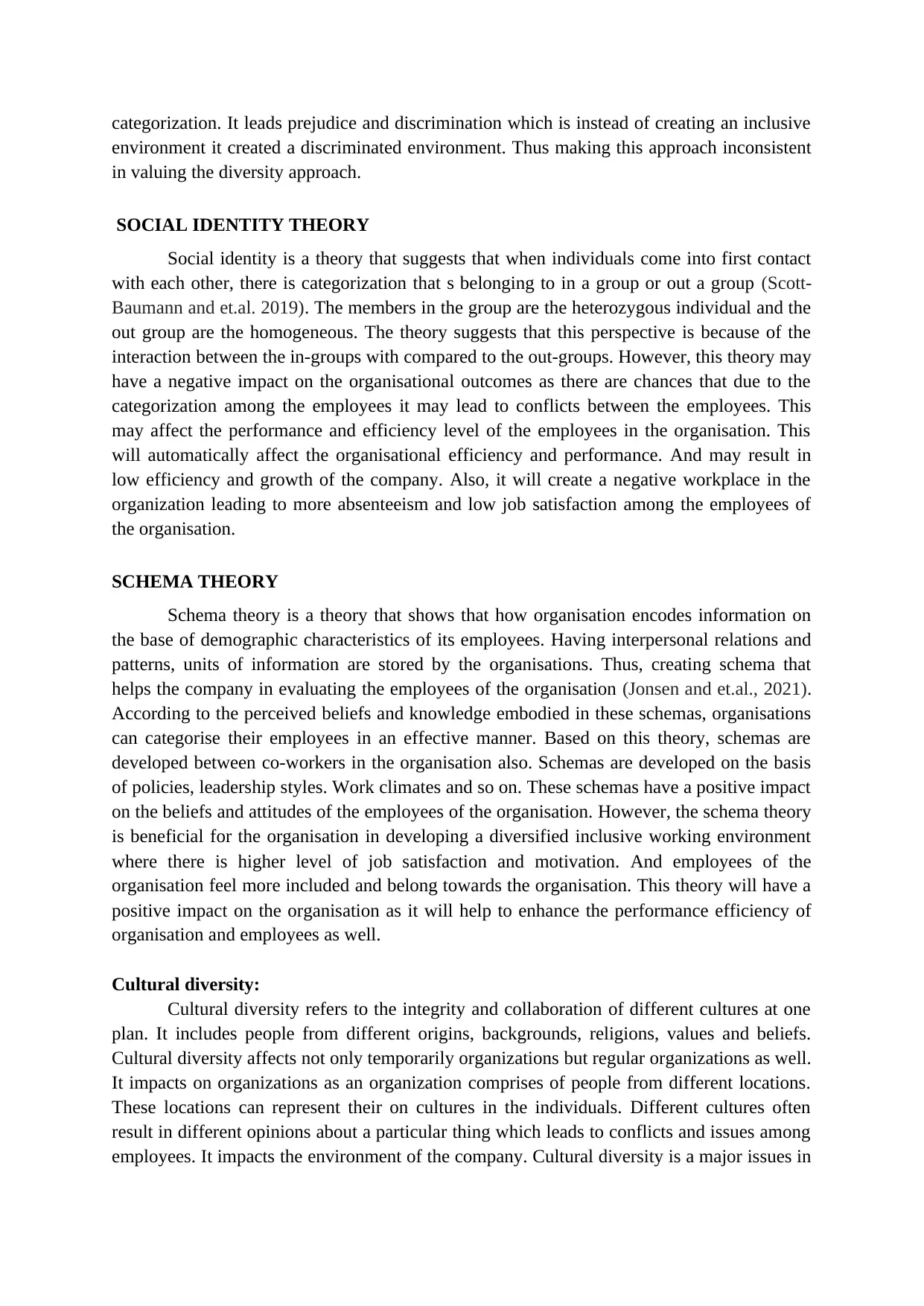
categorization. It leads prejudice and discrimination which is instead of creating an inclusive
environment it created a discriminated environment. Thus making this approach inconsistent
in valuing the diversity approach.
SOCIAL IDENTITY THEORY
Social identity is a theory that suggests that when individuals come into first contact
with each other, there is categorization that s belonging to in a group or out a group (Scott-
Baumann and et.al. 2019). The members in the group are the heterozygous individual and the
out group are the homogeneous. The theory suggests that this perspective is because of the
interaction between the in-groups with compared to the out-groups. However, this theory may
have a negative impact on the organisational outcomes as there are chances that due to the
categorization among the employees it may lead to conflicts between the employees. This
may affect the performance and efficiency level of the employees in the organisation. This
will automatically affect the organisational efficiency and performance. And may result in
low efficiency and growth of the company. Also, it will create a negative workplace in the
organization leading to more absenteeism and low job satisfaction among the employees of
the organisation.
SCHEMA THEORY
Schema theory is a theory that shows that how organisation encodes information on
the base of demographic characteristics of its employees. Having interpersonal relations and
patterns, units of information are stored by the organisations. Thus, creating schema that
helps the company in evaluating the employees of the organisation (Jonsen and et.al., 2021).
According to the perceived beliefs and knowledge embodied in these schemas, organisations
can categorise their employees in an effective manner. Based on this theory, schemas are
developed between co-workers in the organisation also. Schemas are developed on the basis
of policies, leadership styles. Work climates and so on. These schemas have a positive impact
on the beliefs and attitudes of the employees of the organisation. However, the schema theory
is beneficial for the organisation in developing a diversified inclusive working environment
where there is higher level of job satisfaction and motivation. And employees of the
organisation feel more included and belong towards the organisation. This theory will have a
positive impact on the organisation as it will help to enhance the performance efficiency of
organisation and employees as well.
Cultural diversity:
Cultural diversity refers to the integrity and collaboration of different cultures at one
plan. It includes people from different origins, backgrounds, religions, values and beliefs.
Cultural diversity affects not only temporarily organizations but regular organizations as well.
It impacts on organizations as an organization comprises of people from different locations.
These locations can represent their on cultures in the individuals. Different cultures often
result in different opinions about a particular thing which leads to conflicts and issues among
employees. It impacts the environment of the company. Cultural diversity is a major issues in
environment it created a discriminated environment. Thus making this approach inconsistent
in valuing the diversity approach.
SOCIAL IDENTITY THEORY
Social identity is a theory that suggests that when individuals come into first contact
with each other, there is categorization that s belonging to in a group or out a group (Scott-
Baumann and et.al. 2019). The members in the group are the heterozygous individual and the
out group are the homogeneous. The theory suggests that this perspective is because of the
interaction between the in-groups with compared to the out-groups. However, this theory may
have a negative impact on the organisational outcomes as there are chances that due to the
categorization among the employees it may lead to conflicts between the employees. This
may affect the performance and efficiency level of the employees in the organisation. This
will automatically affect the organisational efficiency and performance. And may result in
low efficiency and growth of the company. Also, it will create a negative workplace in the
organization leading to more absenteeism and low job satisfaction among the employees of
the organisation.
SCHEMA THEORY
Schema theory is a theory that shows that how organisation encodes information on
the base of demographic characteristics of its employees. Having interpersonal relations and
patterns, units of information are stored by the organisations. Thus, creating schema that
helps the company in evaluating the employees of the organisation (Jonsen and et.al., 2021).
According to the perceived beliefs and knowledge embodied in these schemas, organisations
can categorise their employees in an effective manner. Based on this theory, schemas are
developed between co-workers in the organisation also. Schemas are developed on the basis
of policies, leadership styles. Work climates and so on. These schemas have a positive impact
on the beliefs and attitudes of the employees of the organisation. However, the schema theory
is beneficial for the organisation in developing a diversified inclusive working environment
where there is higher level of job satisfaction and motivation. And employees of the
organisation feel more included and belong towards the organisation. This theory will have a
positive impact on the organisation as it will help to enhance the performance efficiency of
organisation and employees as well.
Cultural diversity:
Cultural diversity refers to the integrity and collaboration of different cultures at one
plan. It includes people from different origins, backgrounds, religions, values and beliefs.
Cultural diversity affects not only temporarily organizations but regular organizations as well.
It impacts on organizations as an organization comprises of people from different locations.
These locations can represent their on cultures in the individuals. Different cultures often
result in different opinions about a particular thing which leads to conflicts and issues among
employees. It impacts the environment of the company. Cultural diversity is a major issues in
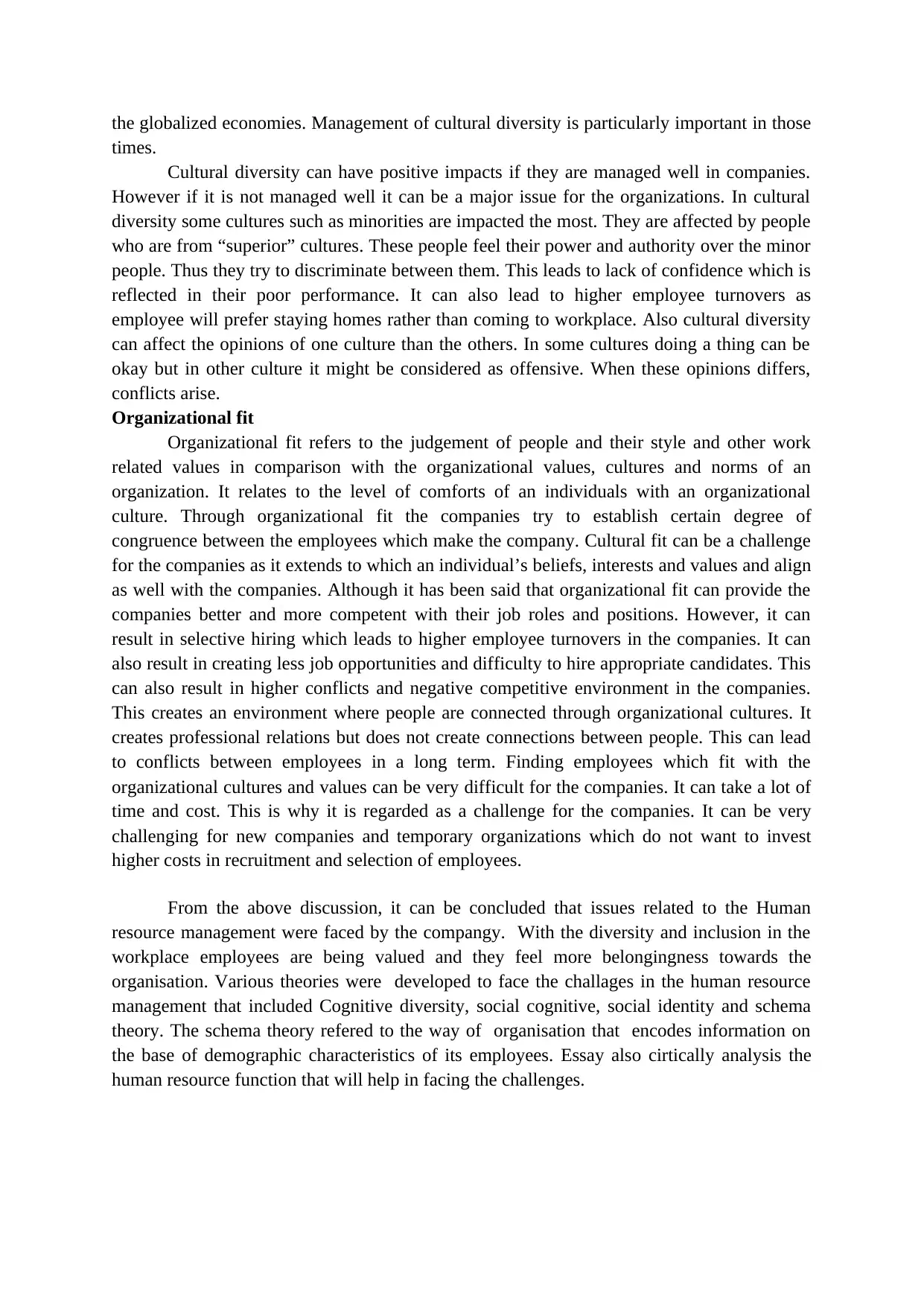
the globalized economies. Management of cultural diversity is particularly important in those
times.
Cultural diversity can have positive impacts if they are managed well in companies.
However if it is not managed well it can be a major issue for the organizations. In cultural
diversity some cultures such as minorities are impacted the most. They are affected by people
who are from “superior” cultures. These people feel their power and authority over the minor
people. Thus they try to discriminate between them. This leads to lack of confidence which is
reflected in their poor performance. It can also lead to higher employee turnovers as
employee will prefer staying homes rather than coming to workplace. Also cultural diversity
can affect the opinions of one culture than the others. In some cultures doing a thing can be
okay but in other culture it might be considered as offensive. When these opinions differs,
conflicts arise.
Organizational fit
Organizational fit refers to the judgement of people and their style and other work
related values in comparison with the organizational values, cultures and norms of an
organization. It relates to the level of comforts of an individuals with an organizational
culture. Through organizational fit the companies try to establish certain degree of
congruence between the employees which make the company. Cultural fit can be a challenge
for the companies as it extends to which an individual’s beliefs, interests and values and align
as well with the companies. Although it has been said that organizational fit can provide the
companies better and more competent with their job roles and positions. However, it can
result in selective hiring which leads to higher employee turnovers in the companies. It can
also result in creating less job opportunities and difficulty to hire appropriate candidates. This
can also result in higher conflicts and negative competitive environment in the companies.
This creates an environment where people are connected through organizational cultures. It
creates professional relations but does not create connections between people. This can lead
to conflicts between employees in a long term. Finding employees which fit with the
organizational cultures and values can be very difficult for the companies. It can take a lot of
time and cost. This is why it is regarded as a challenge for the companies. It can be very
challenging for new companies and temporary organizations which do not want to invest
higher costs in recruitment and selection of employees.
From the above discussion, it can be concluded that issues related to the Human
resource management were faced by the compangy. With the diversity and inclusion in the
workplace employees are being valued and they feel more belongingness towards the
organisation. Various theories were developed to face the challages in the human resource
management that included Cognitive diversity, social cognitive, social identity and schema
theory. The schema theory refered to the way of organisation that encodes information on
the base of demographic characteristics of its employees. Essay also cirtically analysis the
human resource function that will help in facing the challenges.
times.
Cultural diversity can have positive impacts if they are managed well in companies.
However if it is not managed well it can be a major issue for the organizations. In cultural
diversity some cultures such as minorities are impacted the most. They are affected by people
who are from “superior” cultures. These people feel their power and authority over the minor
people. Thus they try to discriminate between them. This leads to lack of confidence which is
reflected in their poor performance. It can also lead to higher employee turnovers as
employee will prefer staying homes rather than coming to workplace. Also cultural diversity
can affect the opinions of one culture than the others. In some cultures doing a thing can be
okay but in other culture it might be considered as offensive. When these opinions differs,
conflicts arise.
Organizational fit
Organizational fit refers to the judgement of people and their style and other work
related values in comparison with the organizational values, cultures and norms of an
organization. It relates to the level of comforts of an individuals with an organizational
culture. Through organizational fit the companies try to establish certain degree of
congruence between the employees which make the company. Cultural fit can be a challenge
for the companies as it extends to which an individual’s beliefs, interests and values and align
as well with the companies. Although it has been said that organizational fit can provide the
companies better and more competent with their job roles and positions. However, it can
result in selective hiring which leads to higher employee turnovers in the companies. It can
also result in creating less job opportunities and difficulty to hire appropriate candidates. This
can also result in higher conflicts and negative competitive environment in the companies.
This creates an environment where people are connected through organizational cultures. It
creates professional relations but does not create connections between people. This can lead
to conflicts between employees in a long term. Finding employees which fit with the
organizational cultures and values can be very difficult for the companies. It can take a lot of
time and cost. This is why it is regarded as a challenge for the companies. It can be very
challenging for new companies and temporary organizations which do not want to invest
higher costs in recruitment and selection of employees.
From the above discussion, it can be concluded that issues related to the Human
resource management were faced by the compangy. With the diversity and inclusion in the
workplace employees are being valued and they feel more belongingness towards the
organisation. Various theories were developed to face the challages in the human resource
management that included Cognitive diversity, social cognitive, social identity and schema
theory. The schema theory refered to the way of organisation that encodes information on
the base of demographic characteristics of its employees. Essay also cirtically analysis the
human resource function that will help in facing the challenges.
⊘ This is a preview!⊘
Do you want full access?
Subscribe today to unlock all pages.

Trusted by 1+ million students worldwide
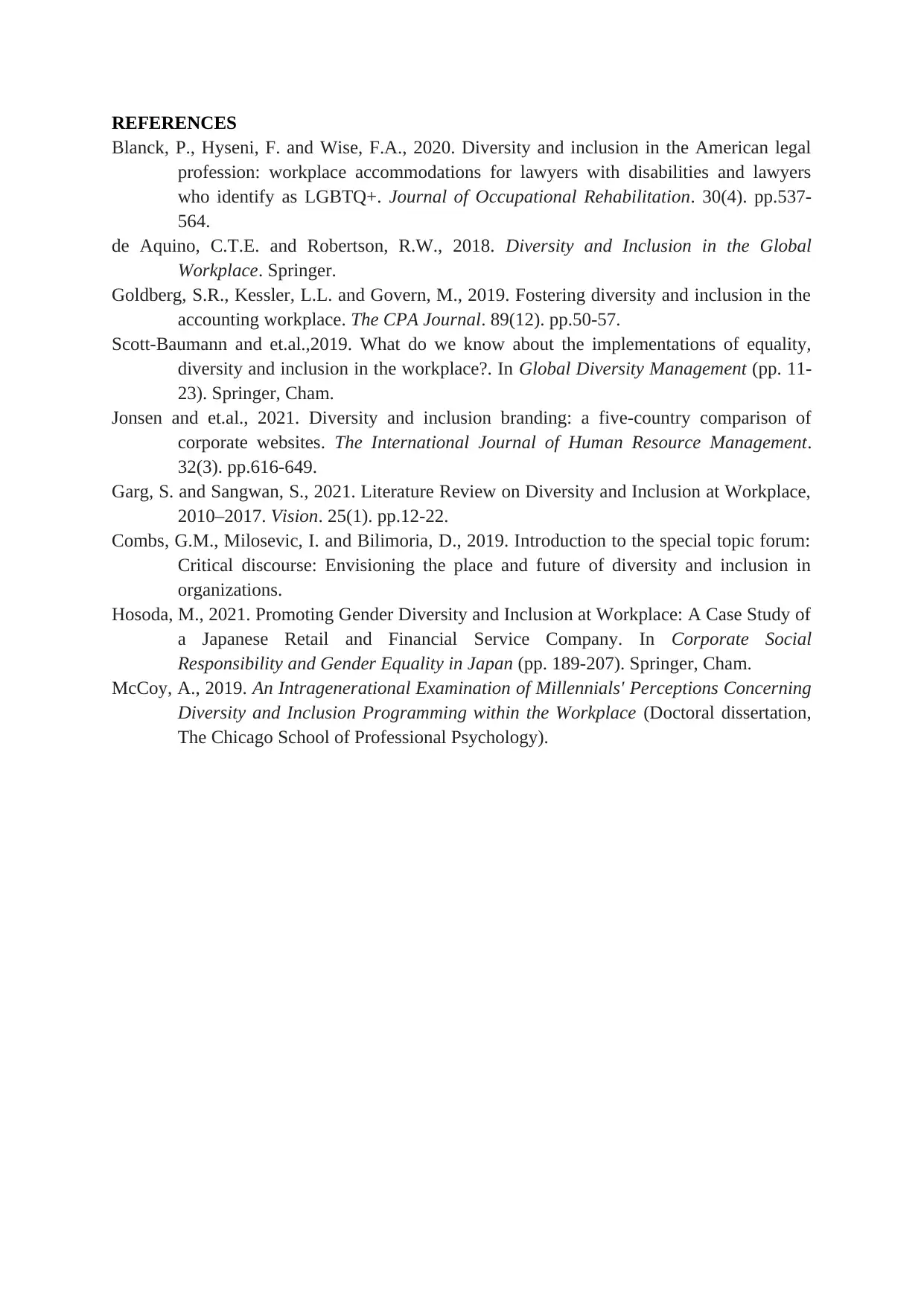
REFERENCES
Blanck, P., Hyseni, F. and Wise, F.A., 2020. Diversity and inclusion in the American legal
profession: workplace accommodations for lawyers with disabilities and lawyers
who identify as LGBTQ+. Journal of Occupational Rehabilitation. 30(4). pp.537-
564.
de Aquino, C.T.E. and Robertson, R.W., 2018. Diversity and Inclusion in the Global
Workplace. Springer.
Goldberg, S.R., Kessler, L.L. and Govern, M., 2019. Fostering diversity and inclusion in the
accounting workplace. The CPA Journal. 89(12). pp.50-57.
Scott-Baumann and et.al.,2019. What do we know about the implementations of equality,
diversity and inclusion in the workplace?. In Global Diversity Management (pp. 11-
23). Springer, Cham.
Jonsen and et.al., 2021. Diversity and inclusion branding: a five-country comparison of
corporate websites. The International Journal of Human Resource Management.
32(3). pp.616-649.
Garg, S. and Sangwan, S., 2021. Literature Review on Diversity and Inclusion at Workplace,
2010–2017. Vision. 25(1). pp.12-22.
Combs, G.M., Milosevic, I. and Bilimoria, D., 2019. Introduction to the special topic forum:
Critical discourse: Envisioning the place and future of diversity and inclusion in
organizations.
Hosoda, M., 2021. Promoting Gender Diversity and Inclusion at Workplace: A Case Study of
a Japanese Retail and Financial Service Company. In Corporate Social
Responsibility and Gender Equality in Japan (pp. 189-207). Springer, Cham.
McCoy, A., 2019. An Intragenerational Examination of Millennials' Perceptions Concerning
Diversity and Inclusion Programming within the Workplace (Doctoral dissertation,
The Chicago School of Professional Psychology).
Blanck, P., Hyseni, F. and Wise, F.A., 2020. Diversity and inclusion in the American legal
profession: workplace accommodations for lawyers with disabilities and lawyers
who identify as LGBTQ+. Journal of Occupational Rehabilitation. 30(4). pp.537-
564.
de Aquino, C.T.E. and Robertson, R.W., 2018. Diversity and Inclusion in the Global
Workplace. Springer.
Goldberg, S.R., Kessler, L.L. and Govern, M., 2019. Fostering diversity and inclusion in the
accounting workplace. The CPA Journal. 89(12). pp.50-57.
Scott-Baumann and et.al.,2019. What do we know about the implementations of equality,
diversity and inclusion in the workplace?. In Global Diversity Management (pp. 11-
23). Springer, Cham.
Jonsen and et.al., 2021. Diversity and inclusion branding: a five-country comparison of
corporate websites. The International Journal of Human Resource Management.
32(3). pp.616-649.
Garg, S. and Sangwan, S., 2021. Literature Review on Diversity and Inclusion at Workplace,
2010–2017. Vision. 25(1). pp.12-22.
Combs, G.M., Milosevic, I. and Bilimoria, D., 2019. Introduction to the special topic forum:
Critical discourse: Envisioning the place and future of diversity and inclusion in
organizations.
Hosoda, M., 2021. Promoting Gender Diversity and Inclusion at Workplace: A Case Study of
a Japanese Retail and Financial Service Company. In Corporate Social
Responsibility and Gender Equality in Japan (pp. 189-207). Springer, Cham.
McCoy, A., 2019. An Intragenerational Examination of Millennials' Perceptions Concerning
Diversity and Inclusion Programming within the Workplace (Doctoral dissertation,
The Chicago School of Professional Psychology).
1 out of 7
Related Documents
Your All-in-One AI-Powered Toolkit for Academic Success.
+13062052269
info@desklib.com
Available 24*7 on WhatsApp / Email
![[object Object]](/_next/static/media/star-bottom.7253800d.svg)
Unlock your academic potential
Copyright © 2020–2025 A2Z Services. All Rights Reserved. Developed and managed by ZUCOL.





